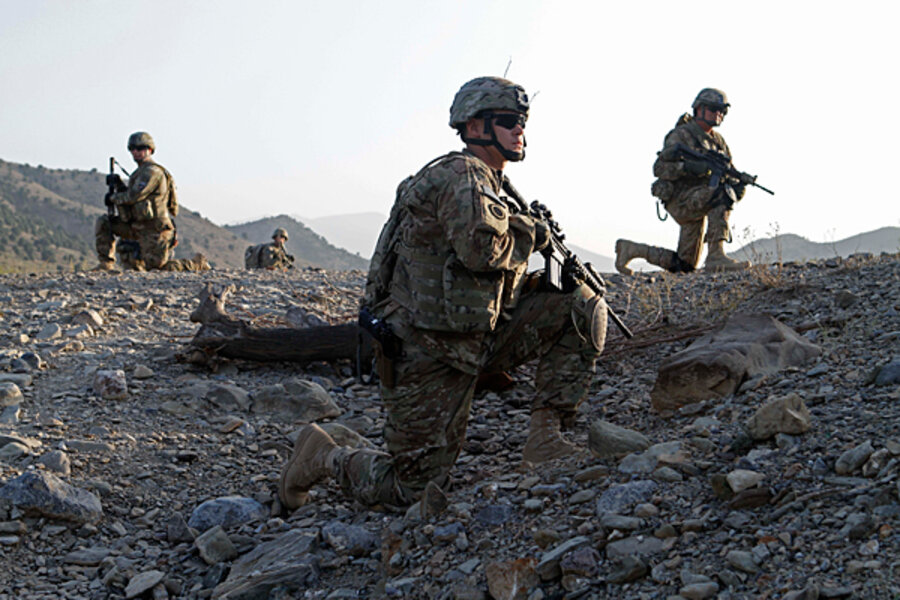US soldiers feel new sense of urgency in Afghanistan war
Loading...
| Paktika Province, Afghanistan
If there’s one place in Afghanistan where America’s counterinsurgency doctrine appears to be working, it’s in a remote corner of Paktika province about 10 miles from the border with Pakistan.
When Gen. David Petraeus took control of US forces in Iraq in 2007 he implemented the doctrine, which relied on separating the insurgency from the civilian population and building infrastructure and local government to prevent militants' return. It was soon adopted by US forces in Afghanistan as well, and some glimmers of success are beginning to emerge.
However, with the 10-year anniversary of the war on Oct. 7 and the troop drawdown already begun, the question may not be whether the US can succeed, but if they have enough time to succeed.
During the past two years, US forces have managed to secure Paktika’s Zerok district and begin building up the local government. Now they’re just beginning to expand efforts into the neighboring Naka District. Despite nearly daily attacks on US troops in Naka until mid-September, among those tasked with securing it, there’s much optimism.
“For the first couple months I was a little doubtful. When we first got here we had trouble getting Afghan forces out [on patrol]. I wasn’t sure how we were going to get it to work. But in the last couple weeks it’s gotten a lot better,” says US Army Lt. Sidney Talley. “I think it’s feasible to get a solid stepping-stone to what a centralized government should look like here.”
Despite the progress in Zerok and Naka, the counterinsurgency strategy the US military is relying on in Afghanistan takes an average of 15 years to work properly, say experts.
Optimism
Among the soldiers, there is some frustration with challenges, but most are confident that they can accomplish their objectives despite the constraints.
“We have a very short timeline and I wish we would have come with that sense of urgency we have now,” says Lt. Col. Rafael Paredes, deputy commander of the 172nd Infantry brigade in Paktika. “We’re running out of time, so we’re really pushing the Afghans to take the lead.”
International forces have invested considerable time and resources into developing Afghan security over the past several years. Afghan forces are now about 300,000-strong. US soldiers throughout Afghanistan say there’s also been substantial qualitative improvements.
“They continue to make progress everyday on their own during independent patrols. They’re really taking the lead without pressure from us,” says Capt. Kevin Koser, executive officer for Bravo Company 2-28 Infantry Battalion. “It’s only going to be as strong as the people who remain here.”
The US military in Afghanistan sees its job now as providing as much stability as possible while legitimizing the Afghan security forces in the eyes of the locals, so they can continue the work.
In Naka district, a remote area situated at the bottom of a valley surrounded by towering mountains, the area has been without any trace of government for years. Most of the residents make their living through farming. Without any real roads, they remain cut off from the rest of the country, and susceptible to militants.
Several years ago, the US funded the construction of a government building there, which was later destroyed by insurgents. If the Afghan government hopes to have any influence in the area, the US military and Afghan forces must find a way to move the region toward lasting stability.
“They really don’t have any governance in Naka, so we’re trying to get in there as soon as possible,” says SFC Dustin Humphrey.
Tensions on the rise
Meanwhile, internal politics in Afghanistan are more tense than they’ve been in years. Fears are mounting that the nation may be headed toward another civil war, especially after the assassination of former president Burhanuddin Rabbani stirred already strained ethnic fault lines.
Many Afghans are concerned that US politicians are either unable or unwilling to significantly alter the Afghan war policy. And the growing sentiment among observers is that no matter how well the US military performs in Afghanistan, the situation may already be beyond its control.
“The military is doing an excellent job, and, really, they are doing more than they are expected to do. But the military cannot compensate for the political leadership,” says Davood Moradian, a professor of political science at the American University of Afghanistan. “There is no political ownership of the Afghan war in Washington, or in Kabul for that matter.”
Still, the question remains, even if US and Afghan forces has time to bring security to a place like Naka, what is the area’s long-term future?
The answer depends largely on what, if any services the local government will be able to provide. Throughout Afghanistan, most district governments lack a budget to do anything more than pay the staff. Money for any projects or development comes from international donor and military support.
“Everywhere in Afghanistan, when there was peace the people stopped supporting the government because it wouldn’t provide services and again insecurity returned,” says Hilaluddin Hilal, a former deputy of the Ministry of Interior and current member of parliament for Baghlan Province. The key to stability in Afghanistan, he says, is a strong, trustworthy government. “If the situation is like this, then you will never have peace anywhere.”





